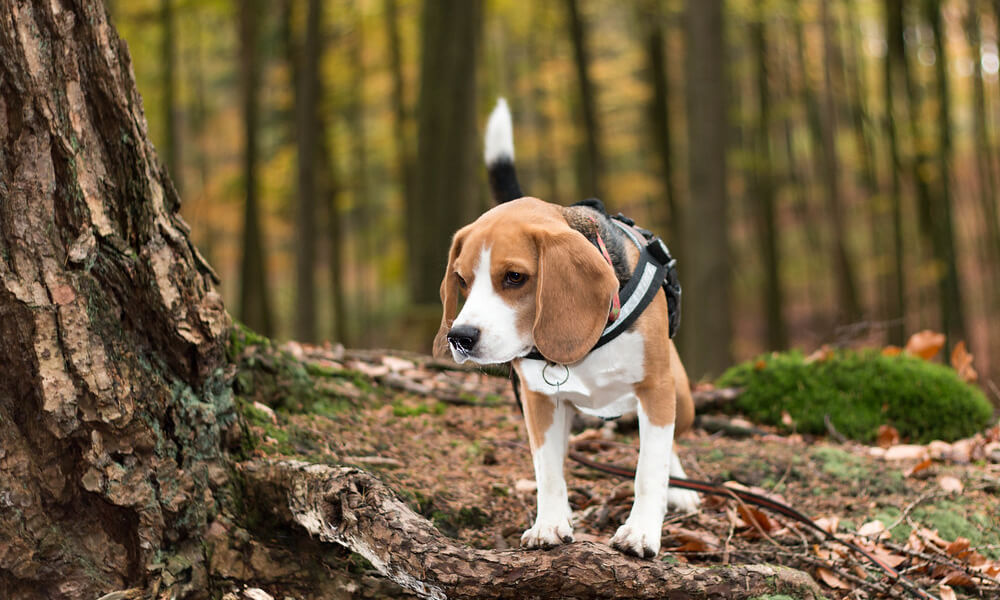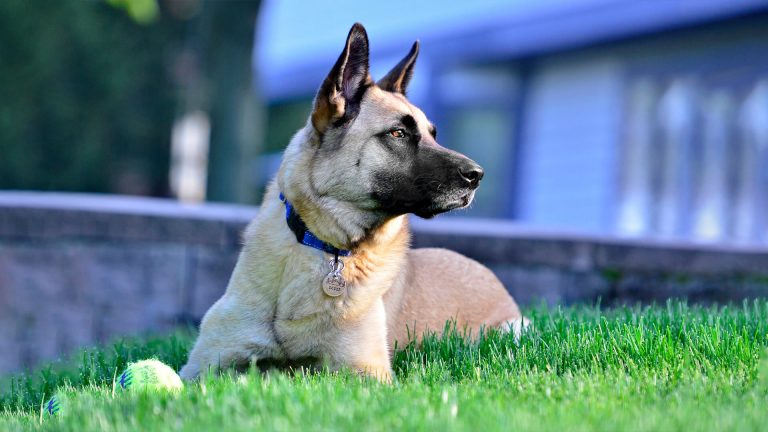The Beagle is a breed of small hound that was developed in England to hunt small game, particularly hares. The breed is thought to have originated in the 1830s, and it is believed to be a descendant of various hounds, including the Basset Hound and the Foxhound. The Beagle is known for its strong sense of smell and its ability to track scents over long distances, which makes it an excellent hunting dog. In addition to its use as a hunting dog, the Beagle is also a popular pet and has been bred to be a friendly and good-natured companion.
Distinctive Features of Beagle
| Breed Name | Beagle |
| Lifespan | Up to 15 years |
| Size | Up to 16 inches tall at the shoulder |
| Weight | 20-30 pounds |
| Coat | Short, dense, and weather-resistant |
| Color | Tricolor (black, white, and tan) or bicolor (lemon and white, red and white) |
| Health risk | Moderate |
| Unique trait | Keen sense of smell, known for tracking scents |
| Famous for | Being scent hounds and excellent hunting dogs |
| Temperament | Friendly, curious, and merry |
| Maintenance | Moderate |
| Adaptability | High |
| Behavior | Generally good, but supervision is recommended |
| Personality | Energetic, playful, and may have a moderate energy level |
| Social | Generally good with other dogs and pets if properly socialized |
The Beagle is a small to medium-sized dog, typically weighing between 18 and 30 pounds. They are generally between 13 and 16 inches tall at the shoulder. Beagles have a short, smooth coat that is typically tri-colored (black, white, and tan) or red and white. They have long, floppy ears and a distinctive, merry expression.
Beagles are known for their strong sense of smell and their ability to track scents over long distances. They are energetic and playful, and they are often used as hunting dogs due to their stamina and ability to follow a scent.
The lifespan of a Beagle is typically around 12 to 15 years, although some individuals may live longer. It is important for Beagles to receive regular exercise and a healthy diet in order to maintain good health and longevity.
In addition to their use as hunting dogs, Beagles are also popular pets due to their friendly and good-natured temperament. They are generally easy to train and are good with children, making them a good choice for families. However, they can be prone to barking and may be hard to housebreak, so it is important for owners to be consistent with training and to provide plenty of positive reinforcement.


How to Take Care of Pet Beagle?
Taking care of a pet Beagle is a rewarding experience filled with love, laughter, and boundless energy. Their affectionate nature and playful demeanor make them a wonderful addition to any family. With their signature floppy ears and wagging tails, Beagles are sure to bring joy and companionship to your life.
How to Setup a Habitat for a pet Beagle?
There are a few key considerations when setting up a habitat for a pet Beagle:
- Space: Beagles need plenty of room to run and play, so it is important to provide them with a large, fenced-in yard or other secure area where they can safely exercise. If you do not have a yard, it is important to take your Beagle for regular walks and provide other opportunities for exercise.
- Shelter: Beagles should have a secure, weather-proof shelter where they can retreat to in inclement weather or when they need to rest. This can be a doghouse, a crate, or a designated area in your home.
- Food and water: It is important to provide your Beagle with a consistent, high-quality diet that meets their nutritional needs. Make sure to have clean water available at all times and to follow the feeding guidelines on the dog food packaging.
- Toys and stimulation: Beagles are intelligent, energetic dogs that need plenty of mental and physical stimulation. Providing your Beagle with a variety of toys and activities, such as fetch, puzzle toys, and training exercises, can help keep them engaged and prevent boredom.
- Training and socialization: It is important to provide your Beagle with consistent, positive training and socialization to help them become well-behaved and well-adjusted pets. This can include basic obedience training and exposure to a variety of people and environments.
What to Feed Your Pet Beagle?
It is important to feed your Beagle a high-quality diet that meets their nutritional needs. Here are a few tips for feeding your Beagle:
- Choose a high-quality dog food: Look for a brand that uses whole ingredients and lists a protein source, such as meat or fish, as the first ingredient. Avoid dog foods that contain fillers, artificial preservatives, or by-products.
- Determine the right portion size: The appropriate portion size for your Beagle will depend on their size, age, and activity level. Consult the feeding guidelines on the dog food packaging or ask your veterinarian for recommendations.
- Offer a variety of protein sources: In addition to commercial dog food, you can also offer your Beagle a variety of protein sources, such as cooked meat, eggs, or cheese. Just be sure to avoid giving them bones, as they can splinter and cause choking or blockages.
- Avoid giving table scraps: While it can be tempting to share your food with your Beagle, it is important to avoid giving them table scraps. Many human foods, such as chocolate, onions, and grapes, can be toxic to dogs.
- Raw Food or BARF Diet: Biologically Appropriate Raw Food (BARF) is also an alternative food choice for Beagles. This raw food diet consisting of uncooked bones, meat, vegetables, and fruits is rich in protein and healthy fat. This will help Beagles have a leaner, more muscular build.
- Homemade Food: If you have a lot of time on your hands, you can make home-cooked food for your Beagle. These meals should be prepared with natural ingredients to create the perfect balance of protein, healthy fat, carbs, vitamins, and minerals. You can either serve your Beagle a chicken meal or a beef meal with sweet potatoes.
- Wet Food: Wet food can be eaten as a standalone meal or mixed with kibble to add variety to your pup’s food. You can also alternate dry food and wet food for your Beagle’s diet. However, keep in mind that wet food can be more expensive and also has a shorter shelf life.
- Provide fresh water: Make sure to have clean water available for your Beagle at all times.
By following these guidelines, you can help ensure that your Beagle receives the proper nutrition they need to maintain good health. If you have any concerns about your Beagle's diet, it is a good idea to consult with your veterinarian.
What to Avoid Feeding Your Pet Beagle?
There are certain foods that you should avoid feeding your Beagle, as they can be harmful or toxic to dogs. Here are a few examples:
- Chocolate: Dogs should not consume chocolate due to its theobromine content, which can be toxic. It can lead to vomiting, diarrhea, rapid breathing, and, in severe cases, even death.
- Grapes and raisins: Even small amounts of grapes and raisins can be toxic to dogs, potentially causing kidney failure. Symptoms may not appear immediately and can include vomiting, diarrhea, and other signs of illness.
- Onions and garlic: Onions and garlic contain substances that can damage a dog's red blood cells, leading to anemia. Symptoms may not be evident right away and can include vomiting, diarrhea, and weakness.
- Macadamia nuts: Macadamia nuts can have negative effects on dogs, causing vomiting, tremors, and increased body temperature.
- Alcohol: Alcohol is toxic to dogs and should never be given to them. It can result in vomiting, diarrhea, breathing difficulties, tremors, and, in severe cases, coma or death.
- Tomato leaves and stems: Beagles should avoid tomato leaves and stems as they are toxic to them. Keep these parts of the plant out of their reach.
- Salt: Excessive salt intake can be harmful to beagles, so it's important to avoid feeding them foods with high salt content.
- Peach pits: Beagles should not consume peach pits as they can cause choking, intestinal blockage, and even cyanide poisoning.
- Sugarless gum: While sugarless gum can be safe for beagles in moderation, excessive consumption may lead to digestive issues.
- Potato leaves and stems: Potato leaves and stems are toxic to beagles and should not be consumed as they can cause gastrointestinal distress and other health problems.
- Apple seeds: Apple seeds contain toxins that can be harmful to dogs, including beagles. Prevent your pet from accessing apple seeds to avoid potential health risks.
- Almonds: It is not recommended to feed almonds to beagles as they can be difficult to digest and may cause health issues.
- Yeast dough: Beagles should not consume yeast dough as it can expand in their stomach and cause serious health complications, or even be fatal.
- Tea: Beagles should not be given tea as it can have harmful effects and contribute to various health problems. It's best to avoid giving tea to your beagle.
- Cinnamon: Cinnamon can irritate a beagle's digestive system and potentially be toxic. It's best to avoid giving cinnamon to your beagle.
- Candy: Beagles should not consume candy as it can be harmful and lead to health issues such as obesity, dental problems, and digestive upset.
- Cat food: Beagles should not eat cat food as it lacks the necessary nutrients tailored for their specific dietary needs, which may result in nutritional deficiencies and health problems.
- Xylitol: Xylitol is highly toxic to beagles and can cause severe health problems, including liver failure and low blood sugar. Keep products containing xylitol away from your beagle.
In addition to these foods, it is also important to avoid giving your Beagle bones, as they can splinter and cause choking or blockages. It is also a good idea to avoid giving your Beagle foods that are high in fat or sugar, as they can contribute to obesity and other health problems. If you have any concerns about what to feed your Beagle, it is a good idea to consult with your veterinarian.
Brushing, Bathing & Grooming Needs of Your Pet Beagle
Beagles have a short, smooth coat that requires minimal grooming. Here are a few tips for caring for your Beagle's coat:
- Brushing: Beagles shed year-round, but their shedding tends to be heaviest in the spring and fall. To help control shedding, it is a good idea to brush your Beagle's coat regularly with a slicker brush or a shedding blade.
- Bathing: Beagles generally do not need to be bathed frequently, as their short coat does not tend to hold onto dirt and odors. It is generally recommended to bathe them every 2-3 months, or as needed if they become excessively dirty or smelly.
- Trimming nails: It is important to regularly trim your Beagle's nails to prevent them from becoming too long, which can cause discomfort and affect their gait. If you are not comfortable trimming your Beagle's nails, you can have a veterinarian or groomer do it for you.
- Cleaning ears: Beagles' long, floppy ears can be prone to ear infections. It is important to regularly clean their ears to prevent build-up of dirt and wax. To clean your Beagle's ears, use a cotton ball or pad moistened with a gentle ear cleaning solution. Avoid inserting anything into their ear canal, as this can cause damage.
By following these grooming guidelines, you can help keep your Beagle's coat and skin healthy and looking its best. If you have any concerns about your Beagle's grooming needs, it is a good idea to consult with your veterinarian or a professional groomer.
Health Concerns of Pet Beagle
Like all breeds, Beagles can be prone to certain health concerns. Here are a few health issues that are commonly seen in Beagles:
- Obesity: Beagles are prone to obesity due to their food-loving nature and sedentary lifestyles. This can lead to increased risks of heart disease, diabetes, and joint problems.
- Cherry Eye: Cherry eye is a common eye problem that can affect Beagles, characterized by the protrusion of the gland of the third eyelid.
- Glaucoma: Beagles are susceptible to glaucoma, a condition caused by increased pressure within the eye, which can lead to vision impairment or loss if left untreated.
- Dental problems: Beagles are prone to dental issues such as tooth decay and gum disease. Regular tooth brushing and dental check-ups with a veterinarian are essential for their oral health.
- Hypothyroidism: Hypothyroidism, a deficiency of the thyroid hormone, is a condition that can affect Beagles.
- Epilepsy: Beagles have a predisposition to epilepsy, a chronic condition characterized by recurring seizures.
- Ear infections: Beagles' floppy ears make them more prone to ear infections. Regular ear cleaning and prompt veterinary attention for any signs of infection are important to maintain their ear health.
- Intervertebral Disk Disease: Beagles, with their short legs and long bodies, are susceptible to intervertebral disk disease, a condition involving the herniation or displacement of spinal disks, which can cause back pain and mobility issues.
- Heart Disease: Beagles may be prone to certain heart diseases, including pulmonic stenosis, which is the narrowing of the connection between the right ventricle and the pulmonary artery.
- Cancer: Beagles can be affected by various types of cancer, such as bone cancer, lymphoma, and bladder cancer.
- Hip dysplasia: Hip dysplasia is a genetic condition where the hip joint does not develop properly, leading to discomfort and lameness. Surgical intervention may be necessary to address this condition.
- Patellar Luxation: Patellar luxation is a common condition in Beagles, where the kneecap dislocates from its normal position, causing pain, lameness, and difficulty in walking. Veterinary treatment is necessary to manage this condition.
By providing your Beagle with regular veterinary care and a healthy diet and lifestyle, you can help prevent or manage these health concerns. If you have any concerns about your Beagle's health, it is a good idea to consult with your veterinarian.
Training and Playing with Pet Beagle
Beagles are intelligent, energetic dogs that need plenty of mental and physical stimulation. Here are a few tips for training and playing with your Beagle:
- Start training early: It is important to start training your Beagle as early as possible to establish good habits and prevent behavior problems. Beagles are generally easy to train and respond well to positive reinforcement, such as treats, praise, and toys.
- Use a consistent, positive approach: Beagles respond best to a consistent, positive approach to training. Avoid using punishment or negative reinforcement, as these can damage the trust and bond between you and your Beagle.
- Enroll in obedience classes: Enrolling your Beagle in obedience classes can be a great way to teach them basic commands and socialize them with other dogs and people. Look for a class that uses positive reinforcement techniques.
- Provide plenty of exercise: Beagles are energetic dogs that need plenty of exercise to stay healthy and happy. Take your Beagle for regular walks and runs, and provide them with plenty of toys and activities to keep them mentally and physically stimulated.
- Play fetch: Fetch is a classic game that is enjoyed by many dogs, including Beagles. It is a great way to provide your Beagle with exercise and mental stimulation, and it can also be a bonding activity for you and your pet.
By providing your Beagle with regular training and plenty of exercise and stimulation, you can help them stay happy and well-behaved. If you have any concerns about your Beagle's training or behavior, it is a good idea to consult with a professional dog trainer or behaviorist.
Facts About Beagle
Here are a few interesting facts about Beagles:
- Beagles are one of the most popular dog breeds in the United States.
- Beagles have a strong sense of smell and are often used as search and rescue dogs, as well as drug-detection dogs.
- Beagles are known for their stamina and are able to run for long distances.
- Beagles were originally bred for hunting small game, such as rabbits and hares.
- Beagles are intelligent and generally easy to train, but they can also be stubborn at times.
- Beagles are affectionate and good-natured, making them a popular choice as a family pet.
- Beagles are known for their distinctive, loud "bay" that they use to alert their owners when they are on the hunt.
- Beagles are known for their friendly and playful nature, and they are often depicted in popular media, such as the "Peanuts" comic strip and the movie "Snatch."
What It's Like to Keep Beagle as a Pet?
Beagles are intelligent, energetic, and affectionate dogs that make great pets. They are generally good with children and are known for their friendly and good-natured temperament. Beagles are also generally easy to train, although they can be stubborn at times.
Beagles are active dogs that need plenty of exercise and mental stimulation. They are known for their strong sense of smell and their love of exploring, so it is important to provide them with a secure, fenced-in yard or take them for regular walks and runs. Beagles are also prone to barking, so it is important to train them to be quiet on command and to provide them with plenty of mental and physical stimulation to prevent boredom.
Beagles are generally low maintenance in terms of grooming, as they have a short, smooth coat that requires minimal brushing. They do shed year-round, however, and may need to be bathed every few months or as needed.
Other Pets to Keep or Avoid with Beagle
Beagles are generally friendly and good-natured dogs that get along well with other pets, including cats and other dogs. However, it is still important to introduce any new pets to your Beagle slowly and in a controlled environment to ensure that they get along.
It is also important to consider your Beagle's energy level and exercise needs when deciding whether to bring another pet into your home. Beagles are energetic dogs that need plenty of exercise and mental stimulation, so it is important to make sure that you have the time and resources to provide for both pets' needs.
If you already have other pets and are considering adding a Beagle to your household, it is a good idea to consult with a veterinarian or a professional dog trainer to ensure that the transition goes smoothly and that all of your pets get along.
Frequently Asked Questions About Beagle
Here are a few frequently asked questions about Beagles:
Are Beagles good apartment dogs?
Beagles are generally active dogs that need plenty of exercise and mental stimulation. While they can adapt to apartment living if they receive enough daily exercise and attention, they may be better suited to a home with a yard where they have more space to run and play.
Do Beagles bark a lot?
Beagles are known for their tendency to bark, especially when they are on the hunt or when they are left alone for long periods of time. Training your Beagle to be quiet on command and providing them with plenty of mental and physical stimulation can help reduce barking.
Do Beagles shed a lot?
Beagles shed year-round, but their shedding tends to be heaviest in the spring and fall. Regular brushing with a slicker brush or a shedding blade can help control shedding and keep your Beagle's coat looking its best.
Are Beagles good with children?
Beagles are generally good with children and make great family pets. They are affectionate and good-natured and are generally patient with children. However, it is important to supervise all interactions between children and dogs to ensure the safety of both.
How long do Beagles live?
The lifespan of a Beagle is typically around 12 to 15 years. By providing your Beagle with a healthy diet, regular exercise, and regular veterinary care, you can help them live a long and healthy life.







